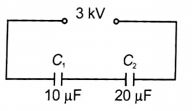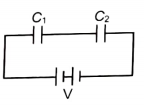Two charge capacitors have their outer plates fixed and inner plates connected by a spring of force constant 'k'. The charge on each capacitor is q. Find the extension in the spring at equilibrium

1.
2.
3.
4. Zero

The following arrangement consists of five identical metal plates parallel to each other. The area of such plate is A and separation between the successive plates is d. The capacitance between P and Q is:
1.
2.
3.
4.
A capacitor is half-filled with a dielectric (K=2) as shown in figure A. If the same capacitor is to be filled with the same dielectric as shown in figure B, what would be the thickness of the dielectric so that the capacitor still has the same capacity?

1. 2d/3
2. 3d/2
3. 3d/4
4. 4d/3
Capacitors and are connected in series across a 3 kV supply as shown. What is the charge on the capacitor C1?

1.
2.
3.
4.
The charge on the 6 capacitors in the circuit shown is:
1.
2.
3.
4.
In the circuit below and . If no capacitor can sustain more than 50 V, then the maximum potential difference between X and Y is:

1. 95 V
2. 75 V
3. 150 V
4. 65 V
In the circuit shown below and . If the charge on C1 is then potential difference between X and Y is
1. 2 V
2. 3 V
3. 6 V
4. 3.5 V
In the circuit below, if a dielectric is inserted into C2, then the charge on C1 will:

1. Increase
2. Decrease
3. Remains same
4. Be halved
A capacitor with plate separation d is charged to V volts. The battery is disconnected and a dielectric slab of thickness and dielectric constant '2' is inserted between the plates. The potential difference across its terminals becomes:
1. V
2. 2 V
3.
4.
An uncharged parallel plate capacitor having a dielectric of constant K is connected to a similar air-cored parallel capacitor charged to a potential V. The two capacitors share charges and the common potential is V'. The dielectric constant K is:
1.
2.
3.
4.









